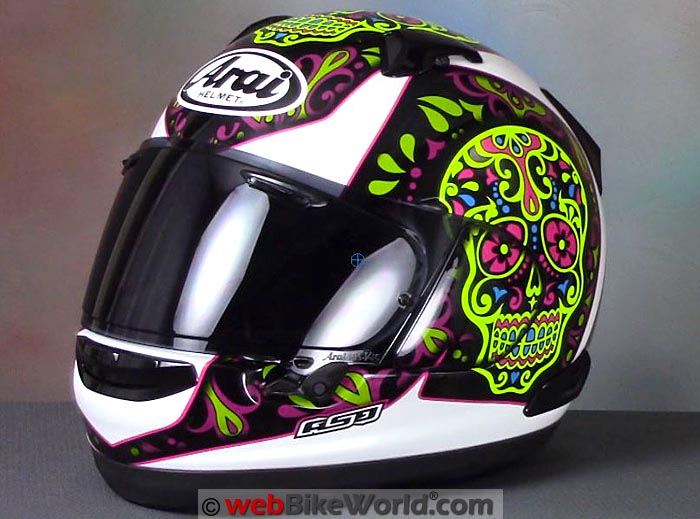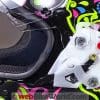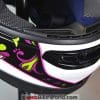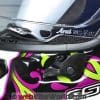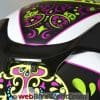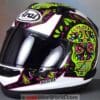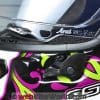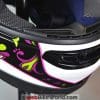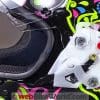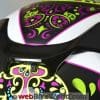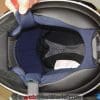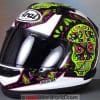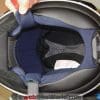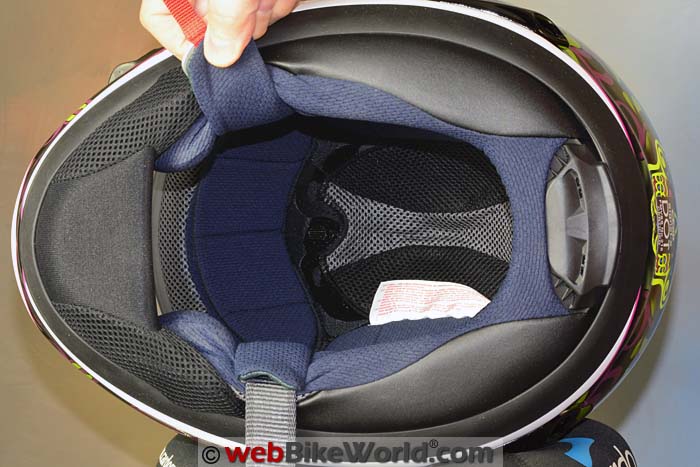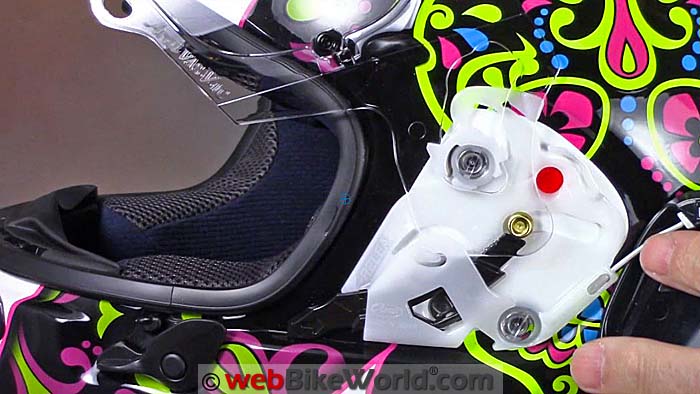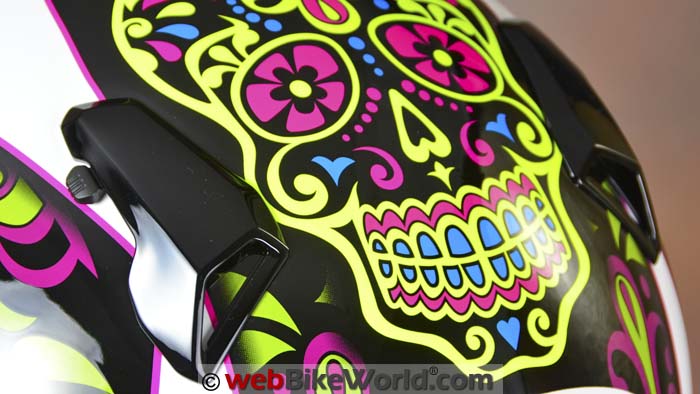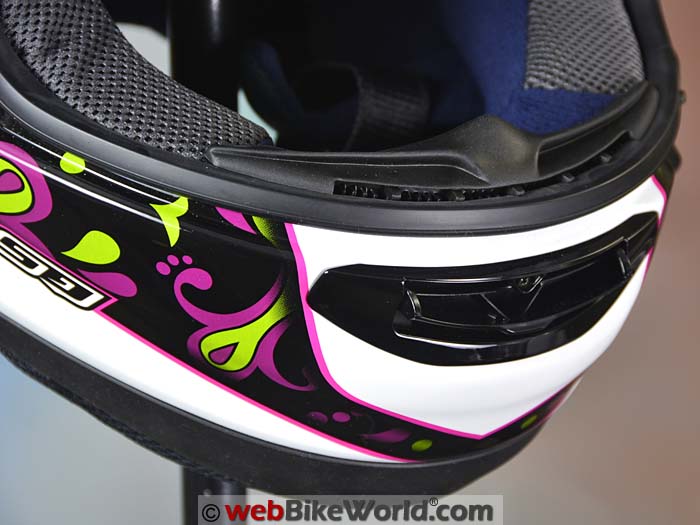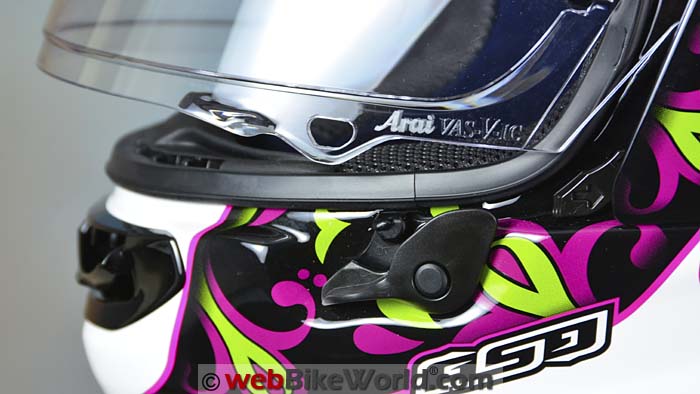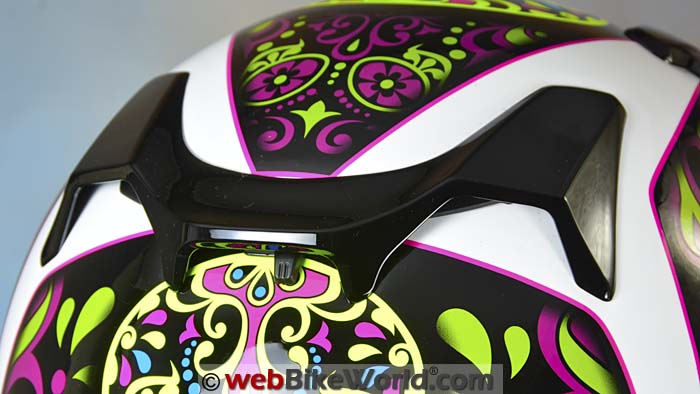“The Narrow X For The Cranium”. OK, so it’s my attempt at cuteness using a very limited knowledge of Spanish. But this new Arai Signet-X in the “El Cráneo” graphics does two things really well. First, it gets you noticed. And second, if you’re a member of the Arai “Long Oval” club, this is your helmet.
The Signet-X is, as far as we can tell, identical to the Arai Quantum-X we reviewed recently in every way other than the internal shape. So the Quantum-X is the Arai “Round Oval” (“Round”) internal shape and the Signet-X is for “Narrow” heads.
Thus, this review will have a lot of duplication from our Quantum-X review, although the difference in the internal shape does lend some interesting differences that we will note.
The “X” tag affixed to the latest Arai helmets designates their latest designs. That includes the top-of-the-line Arai Corsair-X (review) and the Arai Quantum-X (review) and now the Signet is the third helmet in the lineup to get the “X” treatment.
The Signet-X replaces, of course, the Arai Signet-Q (review). Whether there will be an “X” equivalent to the Arai Signet-Q Pro Tour (review) remains to be seen. The top of the Arai helmet lineup is still occupied by the Corsair-X, while the Quantum-X and Signet-X now share duties as the slightly less racy sport biking twins in the VP position.
The Corsair-X is outstanding in every way, at a slight cost in both money and noise levels. Otherwise, for the majority of street bikers, the Quantum-X or Signet-X have all of that Arai goodness for $170.00 less.
Paint, Graphics and Overall Quality
The Signet-X has that same solid Arai feel and other than the wild “El Cráneo” graphics on our helmet and the “Long Oval” internal shape it is, as far as we can tell, identical to the Quantum-X in every way. While our Quantum-X was in basic solid white, the El Cráneo graphics are about as colorful as you’ll ever see on any motorcycle helmet.
And the colors are even (sort of) high-viz, which adds some visibility to hopefully cut through the gadget-induced fog of the typical SUV jockey. When we first ran our eyeballs over the El Cráneo graphics, it brought to mind the old Bell Apex (review) from 2006 in the “Yakuza” graphics.
That design wasn’t so popular but the “Day of the Dead” themed El Cráneo graphics may go over pretty well. The overall helmet quality and the design — whether you like it or not — is perfectly executed on this Signet-X, as you’d expect from a (I hope you’re sitting down) $829.95 list price helmet.
Whether any motorcycle helmet is worth that much money is up to you and there are die-hard Arai fans out there who wouldn’t even look at another helmet. I can say that in theory, it would probably cost you a few hundred bucks to, say, have a white Signet-X custom painted, so there’s that. In any case, the Signet-X is everything you’d expect from a modern Arai motorcycle helmet. And then some, if you consider the El Cráneo graphics.
Score: The Signet-X gets an “Outstanding” rating for paint and quality. See the Summary Table at the end of this page for a description of our rating system.
The “Long Oval” Internal Shape
The original Arai Quantum II (review) from about 15 years ago was a lifesaver for “Round” headed riders. It was discontinued for several years until it was revived in the form of the Quantum-X. The Quantum series — at least in the U.S.A. — had the Arai “Round Oval” internal shape.
The Signet series has been around at least that long and more and it’s been one of the most popular helmets in the Arai lineup. It has the classic Arai “Long Oval” internal shape, said to be the most common head shape for North American riders.
It’s narrower even than the Arai “Intermediate Oval” (read: “Neutral”) helmets like the Arai RX-Q (review), which is now apparently gone from the Arai product line. Arai says the “Long Oval” shape is “Longer front-to-back and a more narrow side-to-side” when compared to the “Intermediate Oval”.
However, the Signet-X still doesn’t seem quite as narrow as older Arai Long Oval helmets, like the also-discontinued Arai Profile (review). I’ve worn them all and I (Rick) have a “Round” or what I call “Earth” shaped head, widest in the middle at the temples and with a flat forehead to boot.
YYet, I can still comfortably fit into the Signet-X, albeit with more room fore-and-aft and at the forehead than the “Round Oval” Quantum-X.
Bottom line here is that the Signet-X is narrower than the Arai “Intermediate Oval” shapes and it’s about the narrowest motorcycle helmet sold today. Note that we have commented on the fact that many helmet manufacturers have somewhat normalized the internal shapes, which are now clustered closer to “Neutral” than they were about 10-15 years ago.
Shell Sizes
I asked Arai about the shell sizes for the Signet-X and here’s what they said:There are 4 shells for the Corsair-X, Quantum-X and Signet-X: XS, SM, ML, XL, XXL and there are 5 shells for the other helmets: XS, SM, ML, XL, XXL/XXXL.
Helmet Fit
The Signet-X in size XL fits as expected for an XL. For more information about head shapes, please read the wBW Motorcycle Helmet FAQ page.
Eyeglass Fit
All of the latest Arai helmets have very good eyeglasses fit, including the Signet-X. I wear the Randolph Engineering Aviator sunglasses (review) with straight temples, designed to fit inside a helmet and they work fine even in the narrower Signet-X.
Liner Comfort
Arai helmets are typically among the most comfortable made and the Signet-X is no exception. The liner and cheek pads are fully removable. The padding is thick and the anti-microbial treated liner fabric feels plush. The Signet-X has narrow removable foam pads under the liner at the 10 and 2 o’clock positions directly on top, which can be removed to adjust the fit slightly.
Again, for more information about head shapes and choosing and fitting a motorcycle helmet, please see the wBW Motorcycle Helmet FAQ page.
As always, remember that helmet fit is crucial to safety and comfort, so make sure you try the helmet on before buying, and try a variety of sizes. The smallest size that fits comfortably is usually the safest.
Score: We give the Signet-X an “Outstanding” for a comfortable fit, a nicely constructed and comfortable liner with comfortable liner material.
Cheek Pads
Like the Quantum-X we reviewed, it’s not immediately apparent how to remove the cheek pads. On both helmets, the emergency release pull tabs are completely hidden under the big chin curtain that is now standard. We think it’s important to ensure that the emergency pull tab label is showing, for the emergency personnel in case you’re in an accident and also because you can use the emergency release pull tabs to remove the cheek pads.
Dig around underneath and you’ll find the orange labels. Be careful though — don’t just start pulling on everything as you’re trying to dislodge the cheek pads.
Also, make sure you look and study carefully how they’re installed, what holds them in and how they are re-inserted. It’s not the same as most helmets, you’ve been forewarned.
When the cheek pads are reinstalled correctly, make sure that the “EMERGENCY” label is just visible, otherwise no one will know about it.
Face Shield, Eye Port and Visibility
The Corsair-X introduced a new Arai face shield design with a completely revised attachment system and it’s now included on the Quantum-X and Signet-X. The points at which the face shield rotates on the sides of the helmet have been lowered and the infamous Arai side pods that have given so many street riders fits have been reduced in size and also completely redesigned.
Arai says that the changes create more smooth helmet shell surface area in the section above the side pods, which helps prevent anything on the helmet from catching or snagging obstructions during a crash and slide. The eye port on the Signet-X is just like the Quantum-X; our feeling is that it’s only about average in terms of outward visibility.
It’s slightly smaller in both the vertical and horizontal planes than the Corsair-X, which is specially designed for racing in a tucked sportbike position.
New Visor and Side Pods
The operation of the newly redesigned face shield system and the revised removal system was described in our Corsair-X review and is fully illustrated in the video included in both our Quantum-X review and in the Signet-X video below.
The side pods now easily release with the push of a lever and the face shield rotating mechanism is then laid bare. It’s very simple to remove and replace the new face shield on the compared to the older system.
By the way, the Signet-X and Quantum-X face shield still has the Arai “infinite” system for raising and lowering. It depends on friction to keep the raised face shield in place.
New Face Shield (Visor) Lock
The other new Quantum-X and Signet-X feature (also first introduced on the Corsair-X) is the face shield lock and catch on the lower left side. It’s a rocker-type lever that pops the face shield off of the lock and allows a (very) small first opening for city defogging/ventilation.
The system easier to use than the old stiff friction snap on older Arai helmets, but it takes some time to learn the new system and develop the muscle memory on the location and operation of the rocker.
The Signet-X (and Quantum-X) also come with the latest generation “Max Vision” Pinlock insert and the face shield has a recess to hold the insert, although the recess is far enough out at the edges to remain unnoticeable.
You’ll need to install the Pinlock for any type of cool-weather riding, because the standard face shield has no anti-fog treatment at all as far as we can tell. But don’t fret; the latest Pinlock inserts are excellent with no discernable distortion. It would have been nice if the Pinlock was installed by Arai at the factory though…
Score: We’ll give the Signet-X an “Excellent” rating for above average outward visibility and the sealing performance of the face shield.
Ventilation Notes
Top Vents
Like the Corsair-X and Quantum-X, the Signet-X continues the Arai tradition for one of the most effective ventilation systems available in any full-face helmet. Arai has been experimenting — or evolving — the top vents on the last few helmet releases and the Quantum-X brings yet another new design. These are angular-shaped scoops with a solid clicking two-position lever located on the outside of each vent.
Having to fuss with two levers rather than one is a bit of a bother and it will take a few tries before your hands figure out the lever location. But one thing’s for sure: the top vents work well, bringing cool air down into the helmet.
Chin Vent
The Signet-X chin vent is standard Arai. It’s what we call the Arai “sugar scoop” (or “feed scoop” for you ex-dairy farmers) type that pours air directly through the chin bar and through a mesh filter bug catcher and then on to your face.
Don’t forget: be careful of how and where you mount the microphone for an intercom system because the air coming through the chin bar vent can generate unwanted background noise in the speakers.
Exhaust Vents
The Signet-X has the same three-hole (on the inside) rear exhaust vent array with a single lever for opening and closing a sliding cover over the dual vent holes. It’s a two-position slider but position one (supposed to be half open) isn’t much different than fully open. This may be a production issue on our particular helmet.
No matter, because we always leave the rear exhaust vent fully open for business, 24/7/365. There are two additional rear exhaust vents along the bottom of the helmet at 4 and 8 o’clock low.
Chin Curtain
The Signet-X and Quantum-X have the big, new, soft, nicely made chin curtain installed at the factory. It’s very nice and it’s effective and much better than the old pull-down chin spoiler.
The old pull-down vestigial chin spoiler is still there, underneath the chin curtain. Arai should eliminate it on their street helmets and save a few pennies.
Score: The Signet-X gets an “Outstanding” rating for ventilation.
Helmet Weight
It’s interesting to note that the Quantum-X we reviewed in size XL weighed 1675 grams. This Signet-X in size XL weights 1704 grams. Perhaps the difference is from the added graphics and clearcoat?
The Signet-X meets the DOT standard in the U.S.A. and it’s also Snell M2015 certified and meeting the Snell certification usually means a slight increase in weight.
For more information, be sure to visit the wBW Motorcycle Helmet Weights page for charts comparing the weights of all of the open-face, full-face and flip-up helmets we’ve reviewed.
Score: The Arai Signet-X gets a “Very Good” rating for weight and balance.
wBW Video: Arai Signet-X
Noise Levels
Similar to the Quantum-X, the new top vent system on the Signet-X is has some minor wind rushing noise when the top vents are open. Close the top vents and the noise decreases almost to nothing. Of course, this will all depend on your motorcycle, how the helmet fits and matches your head shape and any windscreen you’re using.
On a motorcycle with a windscreen that directs air right at the top 1/4 of the helmet, the open top vents will generate a lot of wind rushing noise. But we always wear high-quality, correctly fitted ear plugs, so this is usually not an issue
The Signet-X does seem to have more noise around the bottom of the the helmet than the Quantum-X, possibly due to the slight mis-match between the Signet-X internal shape and my head shape.
Note that our helmet evaluations are a combined effort of several riders over time on different types of motorcycles with and without windscreens. Evaluators wear correctly fitted, high quality ear plugs (even when evaluating motorcycle intercom systems).
Always protect your hearing when riding a motorcycle. See the wBW Earplug Reviews for more information on choosing and wearing earplugs.
Note also that perceived noise levels will vary, depending on the individual. Noise can be caused by many factors, including helmet fit, the type of motorcycle and windscreen, wind speed and direction and even the rider’s clothing. For more information on helmet noise, visit the wBW Motorcycle Helmet Noise page.
Score: The Signet-X gets a “Very Good” rating for noise control.
Intercom and Speaker Fit
The Signet-X and Quantum-X both have a design that works when fitting an intercom clamp, because there’s no fancy gasket molding around the bottom of the helmet shell.
The ear pockets are deep enough to fit speakers, but there is no specific speaker recess although there is a slight depression that can be felt under the ear pocket lining.
Miscellaneous
Yet again, the length of the chin strap padding is too short. It’s way past time for Arai to fix this problem. We’re surprised that on a new helmet designs like the Signet-X and Quantum-X, designed for street and touring, that this problem wasn’t resolved.
Safety Standards
The Signet-X meets the DOT standard in the U.S.A. and it is Snell M2015 certified. See the webBikeWorld report “ECE vs. DOT Helmet Safety Standards” for more information on the difference between DOT and Snell. Also, here is information on the Snell 2015 standard.
Conclusion
The Arai Signet-X is the answer for riders with “Narrow” head shapes and it brings all of the new Arai “X” features to their “Long Oval” head shape helmet, completing the triumvirate. However, you’ll pay for the privilege, as the list price starts at $679.00 and goes up from there with the various graphics and patterns.
More webBikeWorld:
| wBW Product Review: Arai Signet-X | |
|---|---|
| Manufacturer: Arai Helmet Ltd. | List Price: $679.95 to $829.95 |
| Colors: Solids and graphics. | Made In: Japan |
| Sizes: XS-2XL | Review Date: May 2017 |
| Shell Sizes: 2 | |
| Rating Scale is subjective: Unacceptable, Poor, Neutral, Very Good, Excellent, Outstanding. | |
Note: Item provided by a retailer, distributor or manufacturer with these Terms and Conditions.


